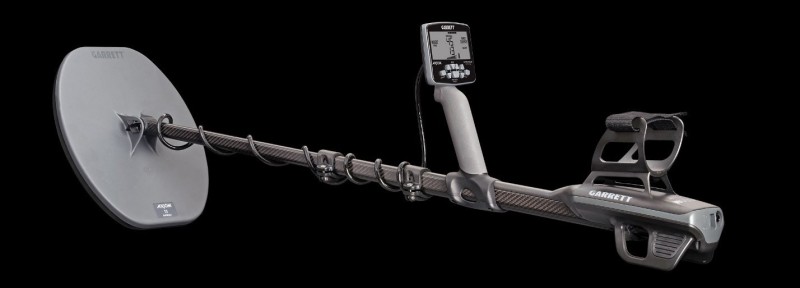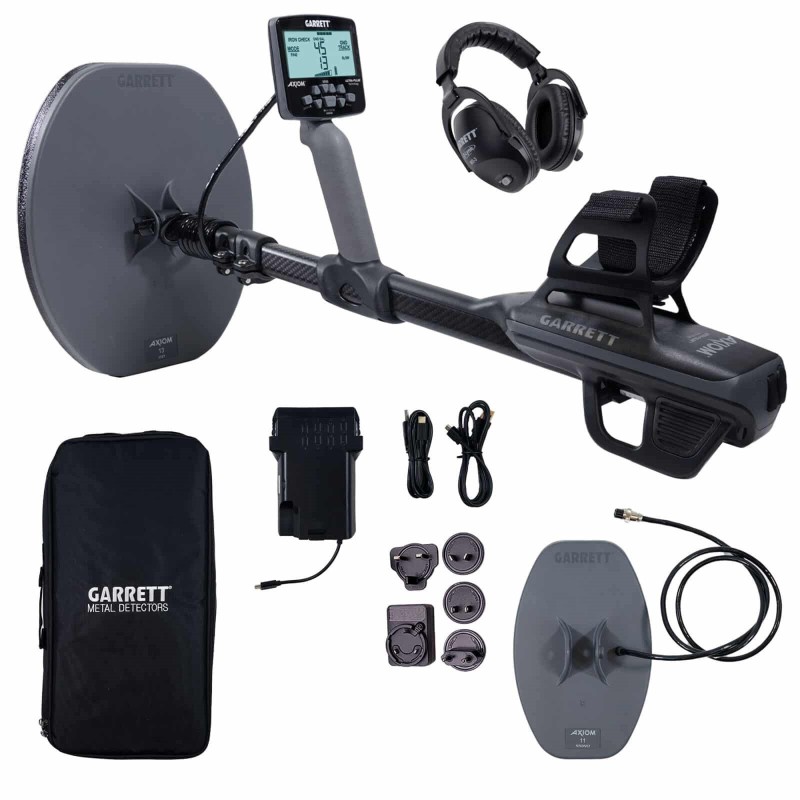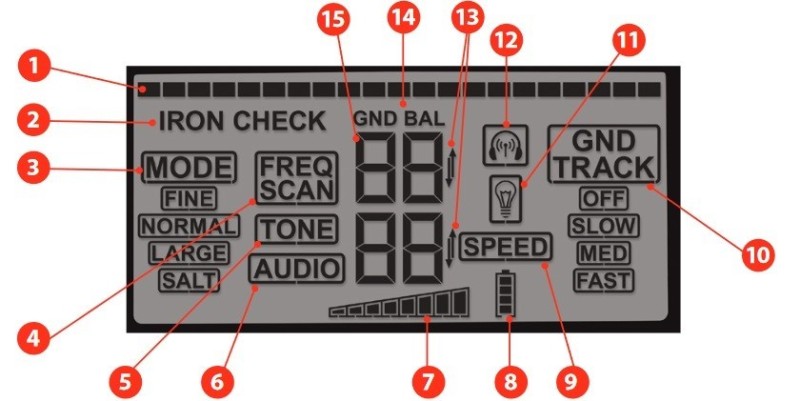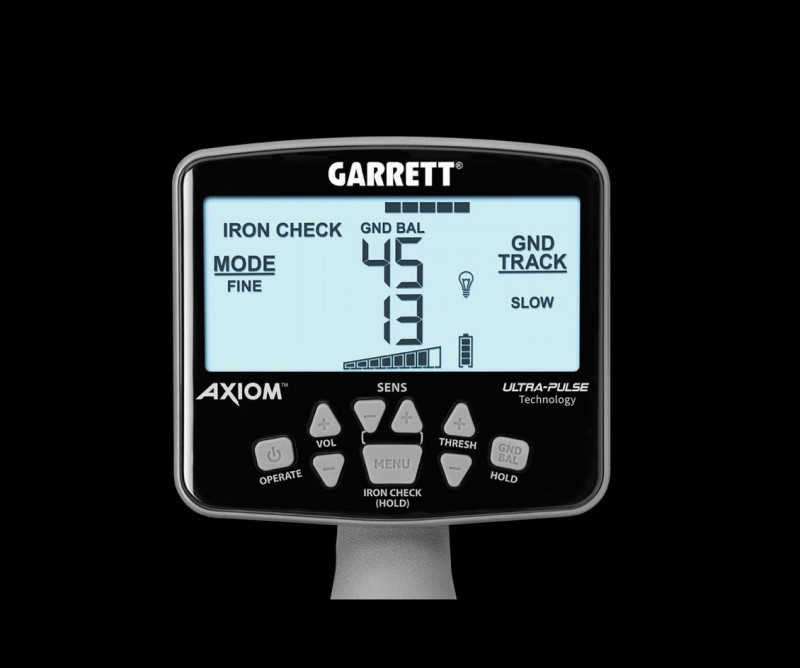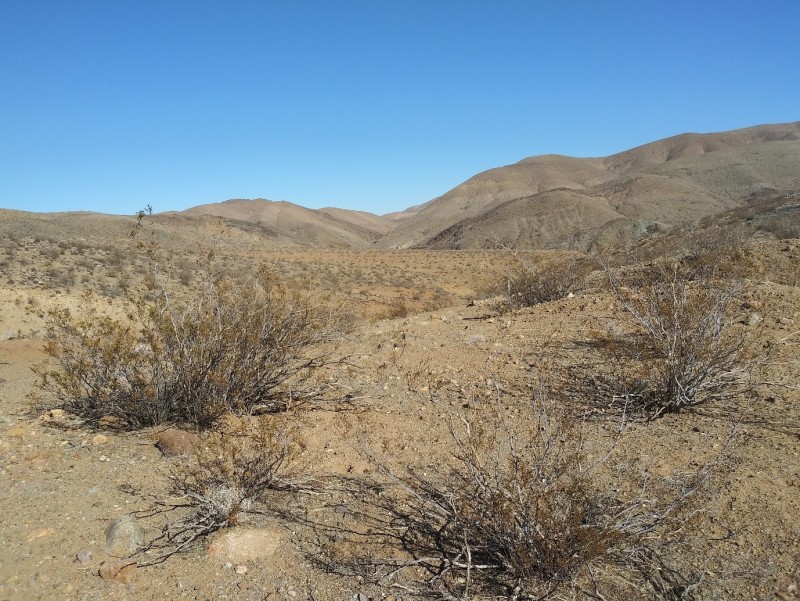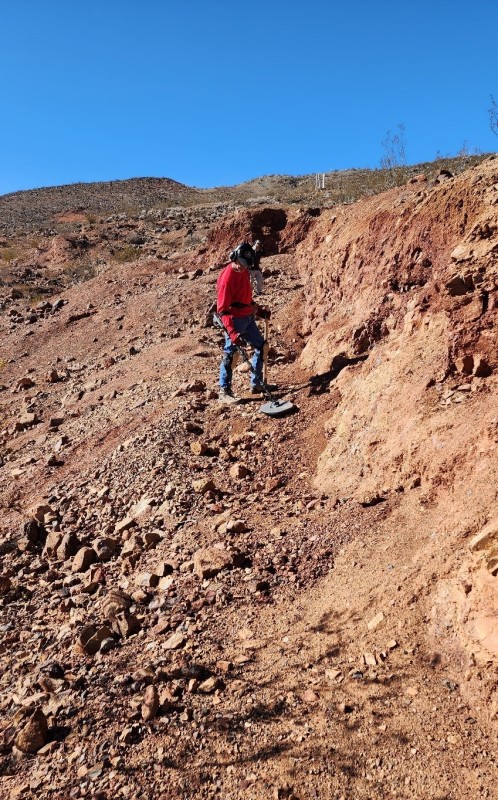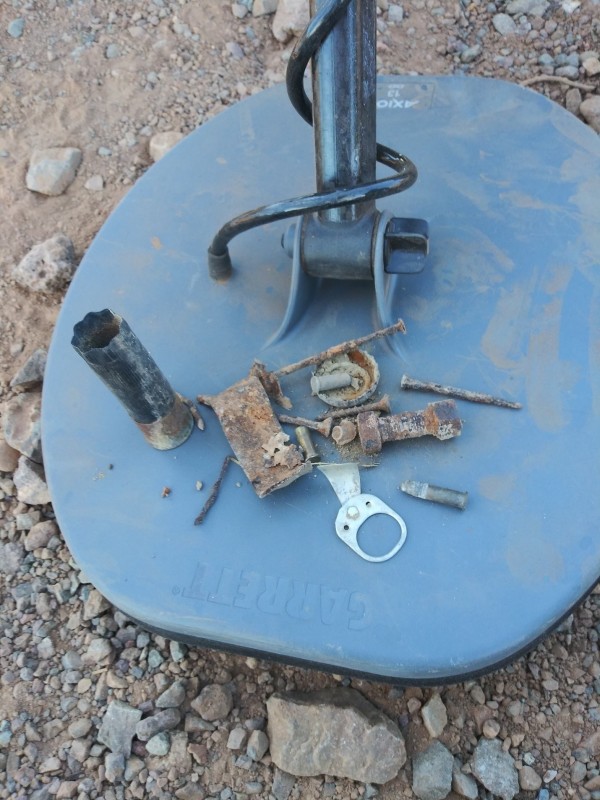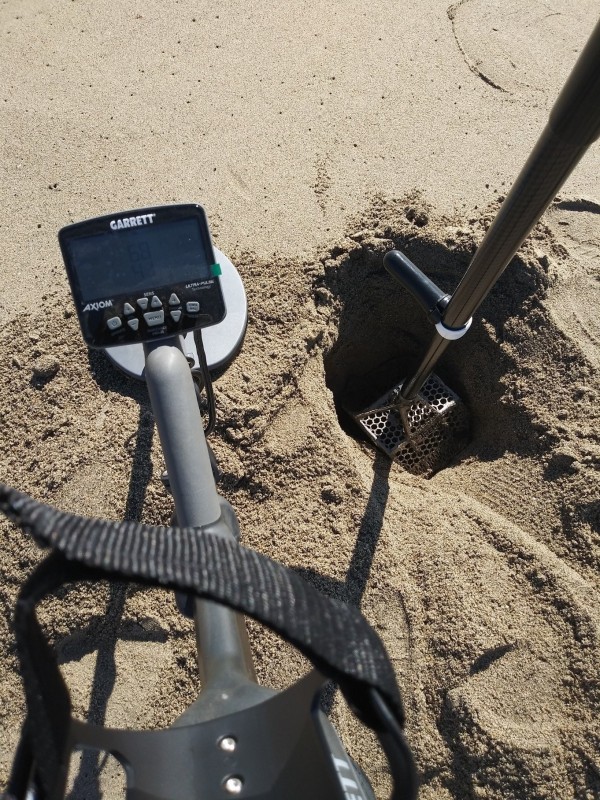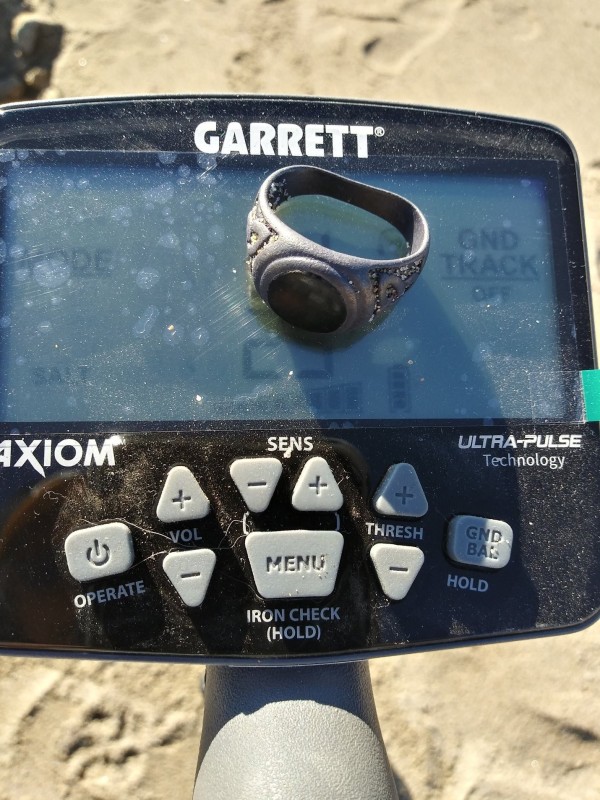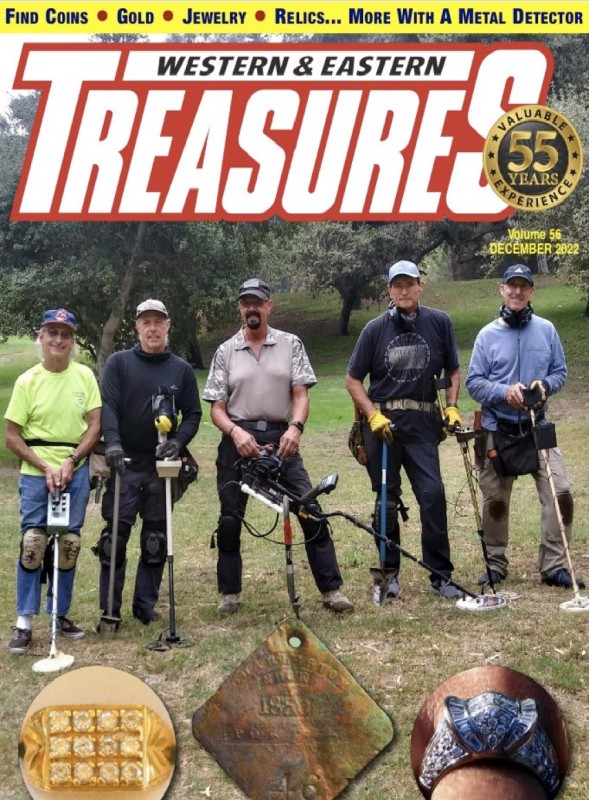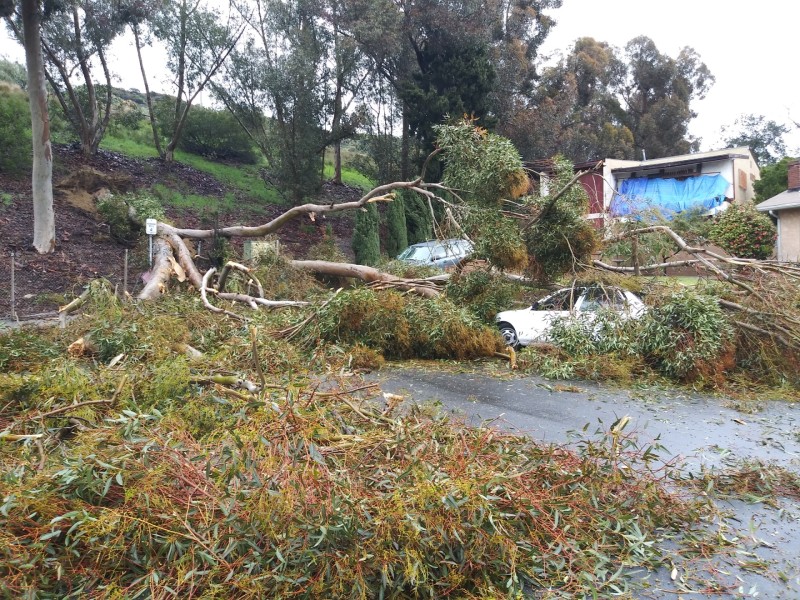-
Posts
369 -
Joined
-
Last visited
Content Type
Forums
Detector Prospector Home
Detector Database
Downloads
Everything posted by Bill (S. CA)
-
I have finally been able to do some hunting with my Legend over the past couple of weeks and really like the increased performance due to the last few updates. However, one still has me baffled. In update 1.07 this change was made: 6. The default Number of Tones for Park and Beach modes have been changed to 2. Like many hunters, I am a tone guy. Yes, I know it's easy enough to change to your preference but I'm just curious as to why Nokta/Makro would make 2 tones the default. I was at the beach yesterday and couldn't understand why I was only getting one high tone on various coins. Then I realized I had done a factory reset recently and sure enough the 2 tone default was back. FYI I dug a quarter in the wet sand at 18" (measured) running sensitivity at 28. Next up is a return to the parks to see how the bottlecap reject performs. Bill
-
I, like many of you, corresponded with Monte many, many times over the years. I always got a kick out of his way of writing up doctoral dissertations to answer any question. The guy could have written the metal detecting version of Homer's Odyssey! It's hard to lose the old, classy guys from our hobby, who were in it just for the fun of it. I hope the good Lord has a Tesoro waiting for him at the Pearly Gates. Bill
-
With all that is and has been discussed about The Legend, both good and bad, it is a bit surprising to me that no one seems to mention its performance at saltwater beaches. Here on the West Coast, outside of mine I have never seen a Legend on our beaches. All I see now are mainly Deus II's and a few holdover Equinoxes. A couple of Manticores are starting to show up. But no Legends. Here's a news flash for you beach hunters: the Legend is a sleeper. A MAJOR sleeper. It will compete with anything currently on the market in terms of depth, sensitivity to small items and stability. I've run an Equinox since it first came out and the Legend is a match for it. My buddies with their Deus II's were a bit surprised that I could hit everything they could hit with their machines. This isn't a sales pitch for Nokta/Makro. Yes, they had a few missteps with introduction of the Legend. Yes, they have gone a bit update crazy. But in its current form, running Version 1.11, it is a serious player if you are a beach hunter. One small comment to finish up with. The grip angle on the Legend is a dream. It is so nice to be able to hold the grip with my entire hand as opposed to have to "finger float" it because the angle was wrong. Bill
-

Deus 2 Coin Hunt High Mineralization
Bill (S. CA) replied to Jeff McClendon's topic in Metal Detecting For Coins & Relics
Jeff, Thanks for making an old school, no video post with God forbid actual pictures of what you found. I also got a kick out of your using a probe or screwdriver. These guys that dig giant plugs for every target would do well to try out a probe once in a while. My first probe was a screwdriver that my dad "blunted" the end on . I still have it and it still works Nothing easier to use on shallow targets. Bill -

Head To Head Comparisons
Bill (S. CA) replied to Johnnysalami1957's topic in Metal Detector Advice & Comparisons
I would partially agree with Digalicious except with regard to the Equinox. The original 800 had pretty good presets in Beach and Park. If you dig through Steve Herschbach's many posts I recall him saying the same thing. I also understand what Johnny...sorry, these handles are just too darn long...is saying. If I'm new to the hobby and have no "teachers" nearby, a good "out of the box" detector would be very valuable to me. Personally I don't mind presets at all. They are a starting point. For some, they may be good enough. I have been detecting a long time and I make my adjustments as I hunt. While I admire Iffy Signals and others who put time into these tests, when you set up a detector on a patio with a piece of wood and two targets you are eliminating so many variables (ground, multiple targets, parts of targets, etc.) that the results, while modestly interesting, just aren't of much value in the real world. Just my opinion, to each their own. Bill -
In the land of YouTube it is difficult to find the discussion of our hobby conducted in a civil tone. You might give this guy a look. He actually hunts, does some tests and applies science and math to detectors. This video is especially interesting in that it points out the different approaches that XP and Minelab take with regard to target ID.
-
Thank you, Jerry. I basically just ran SALT and Slow, tracking off, ground balancing randomly. This is in the wet sand mind you. On the dry I ran FINE. I could run the sensitivity up to 6 in the wet before things got noisy. Easiest PI I have ever used. I am still curious after more hours on it if I can beat the multi's at the beach where they rule right now. Outside of an old White's you never see PI's at the beach anymore. By the way, I highly recommend the DD coil. Being a VLF guy by trade it really made locating targets easy for me. Bill
-

Gold Seeker Adventures Xceed6000 Video
Bill (S. CA) replied to Goldseeker5000's topic in Detector Prospector Forum
Really cool video. You sure worked for your gold. All of that clearing must've been exhausting! -
Field Test: Garrett Axiom By Bill Paxton For those of you who are frequent readers of Western and Eastern Treasures, you may recall back in December of 2021 I did a field test on the Garrett 24K Goldmaster metal detector. An excellent VLF gold machine, the 24K was Garrett’s rebranding of the White’s 24K Goldmaster and a perfect legacy choice to honor the White’s brand that they had acquired in October of 2020. Since the 24K Goldmaster was not a Garrett-developed product, I was very curious as to what Garrett had in the works for 2022. While their competitors were literally leapfrogging each other in the hobby market, Garret was curiously quiet. What were they up to I wondered? A new detector based on the Multi-Flex technology they had introduced in the Apex? Maybe a new water machine? The months ticked by. Still Garrett was quiet. Then came October 5, 2022. That was the day that Garrett revealed to the metal detecting community that their company was all in when it came to one thing. Gold. The 24K Goldmaster was a precursor of things to come. Or to be more specific, one amazing thing to come. The Garrett Axiom. A complete from the ground up redesign of pure pulse induction technology in a package unlike anything that had ever been seen before in the gold prospecting niche of our hobby. Gone were the bulky rigs that required harnesses to swing them and car-size batteries to supply power. No more annoying nobs and confusing settings. What Garrett delivered was a genuinely new and yes, I’m going to say it, exciting metal detector. The first pictures of the Axiom looked like something out of the space age. This was a detector that I wanted to try out and I’m not even a gold prospector. When Steve Moore, the Director of Marketing for Garrett, emailed me and asked if I would like to try one out I couldn’t type the word “YES!” fast enough. Let me pause here briefly and give you a bit of a spoiler alert regarding this field test. As you can tell from the introduction I’ve written above, the Axiom got me pretty revved up even before I held one in my hand. I have used it in the gold fields and at the beach and it flat out delivers. This metal detector is a game changer and I’m genuinely excited to share this field test with our loyal readers. With that being said, let’s get to the field test. The Garrett Axiom The Garrett Axiom There is a great deal to cover on the Axiom beginning with its design. As you can see from the photos, when I describe the Axiom as looking like “something out of the space age” I wasn’t kidding. I’ve used PI detectors for many years, primarily to hunt saltwater beaches because of their inherent ability to deal with high mineralization and find targets at extreme depth. They did, and do, work but at a cost. Due to their often bulky designs, they can beat you up physically. Walking on a beach for several hours with one of those beasts takes its toll and the fatigue factor inevitably shortens your hunts. The Axiom completely negates that negative aspect by its well-balanced and relatively lightweight design. It comes in at roughly 4.5 lbs. depending on the coil you select and features a lightweight internal lithium battery encased in a molded plastic case. An open flexible and very comfortable arm cuff is mounted on the rear of the detector and can be adjusted if required. The hand grip is easy to grasp and topped by a control box modeled after the Apex. A slick carbon fiber shaft that uses innovative stem clamps for adjustment connects to a variety of lightweight coils. All of this means just one thing: you can swing this detector for hours and not suffer for it in the least. One more thing. When you are transporting the Axiom, or if you wish to shrink it down to hunt in close quarters, it easily collapses to a remarkable 25”. The stem clams work as promised and save you the hassle of pushing in those annoying little spring buttons every time that you adjust the shaft. The Axiom Package The Axiom Package Garrett provides a very impressive package of accessories with the Axiom. Along with the detector and searchcoil (this can vary by the package selected), you get: Axiom Booster Pack Soft Carry Case Quick Start Guide Warranty Card USB Charging Cable Wall Charger and Adaptors A set of MS-3 Wireless Headphones with charging cable (Yes, you get Z-Lynk with the Axiom!) A small gripe is that a copy of the full owner’s manual is only available online. I really like a printed copy for reference and wish that one was included. Axiom Coils Garrett offers a large selection of coils for the Axiom: 11” X 7” Mono AND DD 13” X 11” Mono AND DD 16” X 14” Mono AND DD Okay, you are probably thinking that the above listing of DD coils for the Axiom are typos. I can assure you they are not. Yes, Garrett has chosen to offer DD coils for the Axiom. For many PI purists this may be heresy since Mono coils have been the standard for PI detectors for many years. However, I can tell you that the DD coils are a great way to go. My test unit came with a 13” X 11” DD coil, along with Mono coils in the other two sizes. Unlike the Mono coils, which are hotter on the edges, the DD coils react to a target like a typical DD coil and are hotter toward the middle of the coil. I personally loved this because I hunt 100% of the time with DD coils on my other detectors and it made for a very easy and intuitive switchover to the Axiom. In comparing it to the mono coils I found no loss in either depth or sensitivity and the DD coil is now my coil of choice. I would not discount a DD if you are looking into purchasing an Axiom. Axiom Power Okay, say this with me. “Ahhhh.” That is what you will say when you pick up an Axiom and see that there is not any bulky battery to deal with. The detector is powered by what Garrett describes as a “2X LIFE” built-in, high-capacity lithium-ion battery that will run 16 hours on a full charge. I can confirm that the battery is exceptional in terms of holding a charge. While I didn’t hunt for 16 hours straight, I did numerous back-to-back hunts totaling over 10 hours each time and the detector always had two bars remaining on the charge indicator. For those of you who just want to play it safe, a separate booster pack battery powered by 8 – AA batteries is included that will supply an additional six hours of hunting time. Axiom Display Panel When Garrett introduced its first multi-frequency metal, the Apex, it featured a brand-new control box design that users instantly embraced. I was very happy to see that Garrett chose to utilize this same design for the Axiom. The display screen features fifteen different elements in a neatly uncluttered arrangement: Signal Strength Indicator Iron Check Mode Frequency Scan Tone Audio Type Sensitivity Battery Level Speed Ground Track Backlight Wireless Headphones Ground Balance Arrows Ground Balance Indicator Ground Balance Values These display elements will be discussed in detail where relevant later in this field test. Axiom Controls Axiom Controls As with the Apex, the six controls on the display box are located in a unique, user friendly “thumb wheel” pattern below the display. All operations and adjustments to the Axiom are easily accomplished by moving your thumb from left to right in order to press the appropriate button. The controls are: 1. Power ON/OFF and Operate a. Used to turn the Axiom on and off. Pressing and holding this button for five seconds restores factory settings. This button also can be tapped to exit the MENU settings. 2. Volume Plus/Minus Buttons a. Used to increase/decrease volume. 3. Sensitivity Plus/Minus Buttons a. Used for two functions. i. To adjust the sensitivity of the detector. ii. To adjust detector settings within the Menu settings. 4. Menu/Iron Check a. Used for two functions: i. Used to access Menu settings. ii. Engaging Iron Check function by pressing and holding this button. b. Ground Balance i. Press and hold this button to ground balance the detector. 5. Threshold Plus/Minus Buttons a. Really handy to increase or decrease the threshold on the fly as opposed to have to go into some sort of annoying settings menu. 6. Ground Balance a. A “hold and bob the coil” button for ground balancing the Axiom. With all the aforementioned features and controls you might think that the Axiom is a complicated detector to run. On the contrary, Garrett really took its time in designing the Axiom to both offer many features AND be easy to operate. After spending many hours in the field with my Axiom I can attest to this. Axiom Functions and Settings Accessing the various functions and settings is extremely intuitive. · How many times have you owned a detector that needed a factory reset and you couldn’t figure out how to do it? Not with Axiom. Press and hold the Power button for five seconds. Listen for a double beep. Done. · Frequency Scan o EMI is a constant enemy a detectorist must battle so frequency scan is a must with today’s modern metal detectors. The Axiom uses a unique system to locate the quietest operating frequency. To perform a Frequency Scan, just push the menu button until FREQSCAN is highlighted, then press the plus button. The Axion scans through 100 frequencies, rechecks the best five and automatically selects the best one. All of this in 45 seconds. This worked flawlessly for me in the field. · Detection Modes o In my humble opinion this is the Axiom’s finest feature. The Axiom provides four search mode operations, each optimized for specific types of detecting. 1. Fine Mode · The preferred search mode of the Axiom, Fine Mode offers the best sensitivity to all sized targets ranging from fine gold to large items. Fine Mode can be susceptible to ground minerals, hot rocks and salt water. 2. Normal Mode · An excellent choice if noise issues are encountered when in Fine Mode. Normal mode provides good sensitivity to most targets but can be less effective on fine gold. 3. Large Mode · For use when focusing on large targets. This mode also reduces susceptibility to hot rocks and highly mineralized ground. 4. Salt Mode · Designed to allow for use of the Axiom in wet salt environments like ocean beaches. As an avid beach hunter, I was particularly interested in how this mode performed. It delivered excellent stability even in high concentrations of black sand. o Accessing the modes was a sinch. Just press the MENU button until the word “MODE” is highlighted. Then press the “PLUS” or “MINUS“ buttons to select the mode. · Volume and Threshold Adjustment o Not much to say here. Super easy to adjust with the PLUS/MINUS buttons. · Tone and Audio Options o Another area where the Axiom shines. Via the Menu button, the user can change the audio pitch and select from two different types of audio. 1. Tone Adjustment · Pushing the Menu button until TONE is selected followed by pressing the +/- buttons allows for scrolling through 100 available tone shifts. o This feature allows the operator to pick a tone that best fits their preferences or hearing ability · Only active with VCO audio (Audio 01) o Audio type 1. The Axiom has two different and very unique audio types, Audio 00 (PWM) and Audio 01 (VCO, also default). These can be accessed by pressing the Menu button followed by the +/- buttons. Both provide continuous audio that responds proportionally to a target’s signal strength allowing the operator to judge a target’s size, depth and shape. · Audio 00 (PWM) o In PWM audio, audio pitch is fixed at either high or low and only the target’s volume increases with signal strength. Preferred by users who like an active, coarse audio response. 1. Audio 01 (VCO Audio) o The preferred mode of most users (including yours truly). Target volume and audio increase proportionately with signal strength and is a real asset in locating faint targets by changes in audio pitch. o Target Signal 1. The Axiom features a Target Signal Strength Indicator at the top of the display. Utilizing a bargraph, the indicator will display high tones proportionally toward the right of center and low tones similarly toward the left of center. · Backlight o The backlight can be activated and adjusted via the Menu button by highlighting the backlight icon. o The backlight automatically activates when scrolling through the menu, a very handy feature. · Speed o A crucial adjustment for your hunting, made easy by the Axiom’s defined speeds of SLOW, MED(IUM) and FAST. This adjustment determines coil sweep speed and also target recovery speed (often referred to as “reactivity). o As with every adjustment on the Axiom, the Menu button gets you to the Speed Settings. The operator needs to pay strict attention to choosing the proper setting in order to ensure the Axiom performs at its best. 1. SLOW · While the manual suggests using the MED setting for general purpose hunting my preference was the SLOW speed. This setting was the most stable of all three and provided excellent depth and sensitivity. However, it is vital that the user sweep slowly. I always ask the question of fast sweepers “what’s your hurry?” In the case of the Axiom, go slow and you will be rewarded. 2. MED(IUM) · The default setting and a good general-purpose selection for most users. It provides good sensitivity and depth and requires a moderate sweep speed. 3. FAST · This speed boosts reactivity to increase target separation but that comes at a cost. EMI and noise chatter can increase making it more difficult to hear faint targets. · Sensitivity o Unlike most metal detectors, the Axiom offers what I would refer to as “sensitivity on steroids.’ While many metal detectors can be run hot at max sensitivity, the Axiom for the most part cannot. Prior to its release, the previous maximum sensitivity of “8” was boosted significantly to allow certain skilled operators in unique hunting situations to push performance to the maximum. The previous maximum sensitivity now is the number 4 selection. For almost all users (including this field tester), 4 provides more than enough power to obtain excellent results from the Axiom and should not be exceeded for general hunting. · Ground Balance o The Axiom features a very sophisticated ground balancing system that is covered in detail in the manual. While offering standard options like manual ground balance and ground tracking, the Axiom has taken ground balancing to another level with several innovations not previously seen on PI metal detectors: 1. Dual ground balance values displayed with both ground tracking on AND off. · This is a terrific visual reference to monitor ground conditions. 2. Ground Balance Window Feature · After ten seconds of ground balancing, the Ground Balance Window activates and allows the operator to eliminate both mineralized soil AND a hot rock. Pumping over the soil and scanning over the hot rock will eliminate both responses (or make them much smaller). · Iron Check o One of the coolest innovations included in the Axiom. Iron check, which only works with DD coils, will generate an iron “buzz” that is easily recognized. To activate this feature just hold down the Iron Check button until it double beeps. Then scan and listen to the buzz. o While this feature worked best on shallow targets, I found it to be a huge asset for both gold prospecting and beach hunting. If I had a deep, small target all I had to do was activate Iron Check and then scan the pile to see if it was iron or not. This was a real time saver and I used it a lot in my testing. · Quickstart and Owner’s Manual o A Quickstart guide is included with that Axiom. The owner’s manual, which is very well written, is only available as a downloadable pdf. · Other references. o Once again Garrett smartly brought in renowned gold hunter Steve Hershbach to host a series of “how-to” videos explaining the Axiom and its use in great detail. Steve’s easy-going manner and excellent on camera skills, combined with his in-depth knowledge of electronic prospecting, make these videos a must see for anyone contemplating the purchase of an Axiom. I found myself going back to them many times and even after learning the Axiom found they served as a huge, free database of knowledge that made me a more skilled operator of the detector. And now on to the field test… Field Test Historically PI detectors have been at their best when it comes to gold prospecting and saltwater beach hunting. These were the two areas that I focused on for my field testing. But before we get to that, let me comment on one aspect of the Axiom that deserves more than just a passing reference. What is that aspect? Its design. I don’t mean anything specific because to focus on just one feature would be unfair. This detector is flat out one of the best designed metal detectors that I have ever had the pleasure of using. The more that I use it the more I appreciate the time that Garrett put into its design. Notice I said “more that I use it.” Having been a field tester of metal detectors for over two decades I can tell you that this is not always the case. I have never tested what I would call a “bad” detector, but on occasion certain detectors take a toll on you just to use them. For example, the grip angle is wrong. Or the balance is off. Or the menus are confusing. Not with the Axiom. Its performance was excellent as you will see shortly. But what really continues to make my day is that the Axiom is just an easy and enjoyable detector to hunt with. Now let’s get to that field test. In the Gold Fields Living in Los Angeles it is difficult to prospect for gold regardless of your method. Getting to areas to look for gold that isn’t in the form of jewelry is especially difficult, although there are certain places where you might have success that are relatively nearby. However, in my mind I wanted to really prospect for gold with the Axiom so I decided to focus on a place you might have heard of: the Mojave Desert. A few hours’ drive from Los Angeles, this massive area holds many gold claims and a ton of history. Through a fellow detectorist I was able to gain access to a mining claim that was known to still be producing gold. Six buddies and I piled into two pickup trucks and we headed out to the desert to make our fortune on a clear Friday morning. Our detecting site, high up in the Mojave Desert Mountains The site we came upon was several miles up in the hills and showed clear evidence of mining activity. Tiling piles were everywhere. We parked and unloaded out detectors. FYI, I had the only pulse machine; my buddies had both multi-frequency units and VLF’s. After having studied Steve Herschbach’s videos the night before (thank you again, Steve!) I felt pretty confident in my ability to run the Axiom so off I went into the land of tailings. Getting started with the Axiom was a breeze: Power up. Adjust threshold - I preferred a barely audible threshold although at times I went with a negative value to run totally silent. In both cases good targets rang through clear and solid. Ground Balance Run Frequency Scan Pair MS-3 Wireless Headphones (optional) - Being out by myself I liked using the speaker but if noise is an issue the MS-3 Wireless Headphones are excellent. Select Detection Mode - I ran Fine Mode exclusively and was very impressed with its sensitivity to all sizes of targets. In the area I was hunting there was no need to utilize either Normal or Large Mode. Go! Over the course of the next six hours, I covered a lot of ground with the Axiom. Targets were few but when there was something there, large or small, the Axiom found it. I really liked the Iron Reject feature in that it allowed me to locate and ignore several tiny ferrous targets in the pile once they were removed from the hole. Having never prospected for gold with a metal detector for this long a period of time I was grateful for the Axiom’s user-friendly design. The main reason? Gold prospecting is hard work! The constant digging in rock hard ground with a pickaxe kicked my butt. The author working a hillside with the Garrett Axiom For those of you who aren’t PI users, there is an audio adjustment that you have to make when using a PI in order to recognize targets. I would strongly urge you to test targets at home before going out in the field. Thankfully I did this and therefore was able for the most part to locate targets easily. Using the DD coil really helped and I was able to use my VLF skills to center and pinpoint targets with very little difficulty. The Axiom found targets of various sizes that included shell casings, bullets, wire, iron junk (ID’d easily by Iron Reject when in the pile), everything but gold. As those of you who prospect for gold know all too well, gold is tough to find and on this day I did not come home with any. The Axiom will find even the tiniest piece of gold as was evidenced by several microscopic bits of wire that hit hard with good, solid repeatable signals. The Axiom was sensitive to both large and very small targets in the heavily worked area. The irony of the day was that one of our party did find gold and he was the only guy who did not use a metal detector. He filled up two large buckets with dirt to take home and pan out and yes, he had gold in his pan when he was all finished. At the Ocean Beach As an avid beach hunter living in Southern California I was really anxious to see how the Axiom performed in a salt environment. Until the advent of multi-frequency detectors, PI’s ruled when it came to depth and performance at ocean beaches. Nowadays you don’t see a lot of PI’s at the beach but they do still have their place when the mineralization is high and causes problems for conventional detectors. There are still PI purists who will argue that a PI can beat any detector for pure depth and they may be right. I had no intention of reopening that debate. All I wanted to do was see if the Axiom could serve as a beach hunting detector. The Axiom was rock solid at ocean beaches and delivered exceptional depth on targets. A long-buried silver ring with an onyx stone was found with the Axiom after a recent storm. The verdict: yes, it can. Thanks to the SALT mode, a beach hunter can easily navigate “the wet” as we call it and punch right through troublesome black sand. In my hunts at the beach I was very pleased with how smoothly the Axiom ran. I could push the sensitivity up to “6” before I had to deal with any falsing. Targets were recovered at impressive depths of well over a foot. Being a PI, some of these were deep garbage but others were coins. That is the compromise you make when hunting with a PI. My best find was a very old, large silver ring, found at a depth of about 6” in a pocket of black sand. The Axiom hit it with no problem. I might add that the Axiom’s relatively light weight and excellent ergonomics made for easy, fatigue-free hunting, something that I have not found to be true of other bulky PI’s that I have used in the past. Another type of beach gold hunting is one that few detectorists explore, that being microgold hunting. For those of you who aren’t familiar with micro-gold hunting, it involves searching for those tiny pieces of gold that VLF metal detectors can’t find. Items like earring backs, thin chains, gold fillings, etc. Gold detectors can be used with good success when searching for microgold due to their ability to find tiny pieces of gold. This type of hunting must be done on the dry since the salt content of the wet sand will wreak havoc with these types of detectors. It requires a great deal of patience since the dry sand holds many types of small bits of metal that conventional VLF’s will not find. It is not for everyone. However, if you elect to try this type of hunting then the Axiom is a superb choice thanks to its FINE MODE. Be sure to bring your Garrett Pinpointer along because you will need it. The Axiom will hit on microscopic pieces of metal like aluminum that you will not see easily with the naked eye. I did a several hour microgold hunt at a local ocean beach and was amazed at how many small targets the Axiom located. If it had been my lucky day, I’m certain some of them would have been gold. Summary, Due to unforeseen circumstances that I will get to in a moment, I was able to spend a much longer period of time using the Axiom than normal. While its gold prospecting abilities have been well documented by many users since its release, there has not been as much focus on the detector as a general use machine, in particular at saltwater beaches where PI’s historically have always performed well. Being a beach hunter, these extra few months gave me multiple opportunities to use the Axion “in the salt” as the saying goes. Generally, I have avoided using a PI as my go-to beach detector because they can be a pain in the neck to use due to their weight, confusing adjustments (for me at least) and the requirement that you have to dig too much garbage. Not that I haven’t tried almost all of them and really tried to love them, or at least like them. The Axiom changed that for me. It is the first PI that I have ever used that was fun to hunt with and performed and felt like a normal metal detector to me. Each time I used it I came to appreciate its brilliantly designed. As a gold prospecting PI I don’t think you can match its performance and value. For saltwater beaches I found it to be a match for any detector that I encountered during my hunts, including all of the latest and greatest multi-frequency machines. If you are looking for a powerhouse saltwater beach detector don’t write of the Axiom as being just a gold prospecting detector. It is a whole lot more. I cannot recommend it more highly as a multi-use metal detector. You can learn more about the Axiom here: https://garrett.com/sport/axiom. Now let’s get to those unforeseen circumstances. This field test was requested by Garrett Electronics and was slated to be published in the January 2023 issue of Western and Eastern Treasures Magazine. I was due to deliver it for publication when the news was released that the magazine was closing its doors for good at the end of 2022. Despite all the work I had put into testing the Axiom and writing up my field test article, it just didn’t seem right for me to keep the unit. I contacted Steve Moore, Director of Marketing for Garrett Electronics, to arrange for the return of the Axiom. To my pleasant surprise, Steve insisted that I hold on to the Axiom and finish my field test in the hope we could find another method of publishing it. Enter Steve Herschbach of DetectorProspector.com Steve said he would gladly publish this field test. He also added that it would be an honor to have it be the last field test written for Western and Eastern Treasures Magazine. To say I was flattered would be an understatement. With that being said, I hope you enjoy this field test of the Garrett Axiom, the last field test written for Western and Eastern Treasures Magazine.
-
As a longtime Minelab user, I was wondering if with all of the testing that is going on in our hobby if anyone has tested the various phases of Minelab's multi-frequency head to head at a salt water beach. While I haven't done any actual testing, I took my old Explorer II with the Pro Coil out a few months back and was pleasantly surprised to find that it would match signals with my buddy's Equinox. The only downside for me was that I couldn't remember the TID numbers. Well that and the fact that swinging the Explorer felt like I was hunting with a boat anchor due to its weight and poor balance. Of all of my Minelab detectors, to this day I had the most fun and found the most gold with my old Sovereign XS with the white coil. I was the first user in the US of Doc's WOT coil which was great for coverage but the weight killed me after hours of hunting. That white coil was my go to coil. I guess the only BBS detector still in the lineup is the now ancient Excalibur II. I wonder if Minelab will ever replace it? Bill
-
George, Like you, I've been at this a while (since 1972 to be exact). I also have a departed wife by divorce. And adult kids. I like to think of metal detecting to have been "my time" which I think we all need. While others may like clubs and group hunts and all of that stuff, I've always enjoyed the solitary existence of me and my metal detector out looking for things. Here in 2023 that hasn't changed. It clears my head and relaxes me and in the world today there isn't much I can find to do that does that for me. To answer the question of your subject line "At What Cost Did My Family Pay For My Addiction?" I would say that there was no cost whatsoever. Rather there was the benefit from your detecting that allowed you to be more of who you are in those special moments with your family. Bill
-
I've been using a pair of basic knee pads for years and finally got sick of getting dirt in the tops and down between the pad and my pants. So I've been trying knee pads and thus far I'm a striking out. Here are the two I've tried: NoCry These were recommended by a buddy. They have too many straps, slip down your legs and the lower pad cuts into your shin when you walk .Selstrom (like Doc's) I liked these but when you bend down the articulated pieces open up a gap into which dirt can get it. Also kind of hard padding. Anybody recommend any?
-
For you guys who don't know midalake, he knows his stuff. He and I have corresponded about beach hunting and he knows how to test.
-
I think my buddy told me that Deep defaults to prospecting audio.
-
Let me share a short story with you. A buddy of mine has a Manticore. I do not. He, like so many others, was following NASA Tom's low conductor recommendation and was lamenting his not finding gold in the wet sand at Santa Monica. I took it upon myself to read the manual online and found this: Deep Salt water beach detecting for small or thin metal objects such as fine jewellery, with aggressive settings for maximum depth� Suitable for dry and wet sand. My buddy wasn't familiar with the setting. He decided to try it the next morning at Santa Monica. In "Deep" he got a good, strong signal that he thought might be gold (I don't recall the number). He switched to low conductor and the detector would barely read it, even when he boosted the sensitivity. He said he would have walked right over it. He dug down what he estimated to be 12"/13". He recovered a 10K diamond ring. I'm not dissing NASA Tom in any way. Just saying that the guys that write these manuals know a thing or two about their detectors, right? Maybe they are worth reading.
-
For those of you who were subscribers to Western and Eastern Treasures Magazine, I wrote an article called "Detecting Through the Decades" for their December 2022 issue. I actually hunted with a 77B Yukon that belonged to Reg Sniff. Everything that has been said about the detector is true. It was fun to use and did find the only silver of the day amongst all of us. That's me on the far left with the 77B. FYI I have kept it for use in sites that are saturated with nails. It does have an uncanny ability to ignore the nails and still hit coins. Steve is the guy who recommended that I include the detector in the article and I'm glad he did. It does make me wonder if that old tech could be rejuvenated in a newer, non-TR detector. Bill
-

Legend Vs Equinox 900 Park Hunt
Bill (S. CA) replied to Jeff McClendon's topic in Metal Detector Advice & Comparisons
Jeff, You have no need to say you are sorry for anything. The types of informational "reports" like the one you shared have almost vanished. Reason? Too many people turn them into science experiments requiring more testing, more trial and error, more detectors and so on and so on. My take on this is if you want more testing do it yourself. I personally don't care a lick about this being weighted and that being weighted when a coin is at a 30 degree angle vs. a 45 degree angle. What's next, that I have to wrap tinfoil around my head and stand on one leg while holding a coat hanger in my off hand to hit a silver dime at 5. 02975647 inches in moderately wet ground beneath an oak tree with a root density of .5? My interest lies in guys like you who know what they are doing using detectors and sharing results. That is why your post has value for people like me. I will add that I have heard similar opinions about the 900 being more than just a bug fix detector. But none of the guys who have shared their results have posted on any forums for exactly the reasons you mentioned. Please continue to share your views and reports, Jeff. And tell the backseat drivers to get their own cars and drive them themselves. Bill


